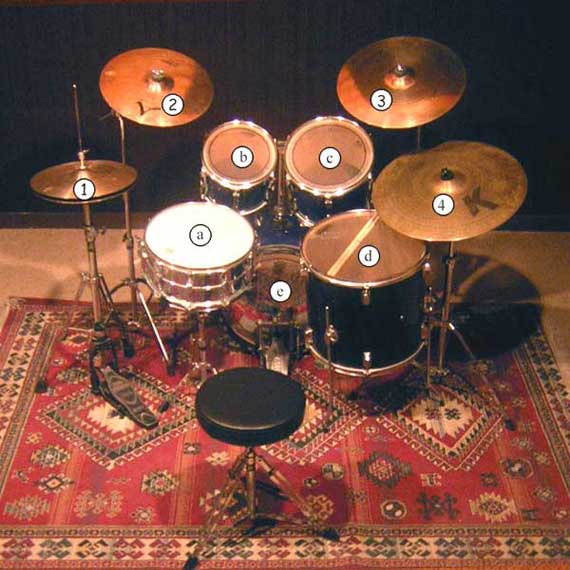
 : : : Lessons : : Conceiving your drum set : Set 4 : Standard rock , free jazz
: : : Lessons : : Conceiving your drum set : Set 4 : Standard rock , free jazz
Set 4 : Standard rock , free jazz
(5 drums, 5 cymbals)

- Description:
-
- 1: Hi-hat 14''
- 2: Crash 16''
- 3 : Crash 18''
- 4 : Ride 20''
-
- a: Snare drum 14 x 6.5'' or 5 "
- b: Suspended high (or tenor) tom 12''
- c: Suspended medium (or baritone) Tom 13''
- d: Low tom (floor tom or bass tom) 16''
- e: Bass Drum 22'' or 20 "
This is the set the most commonly found today in commercial kit (and therefore economic) or in rehearsal studio because it is a kind of average. It is the set the most all purpose, which will allow any drummer to find one's bearings (and nothing prevents to remove some instruments to approach the sets 1, 2 or 3). He appeared with the invention of dual tom holder on bass drum shell, in the 1960s.
Preceding and following explanations must nevertheless convince you that this type of set has no reason to freeze and personally I'm against it, because it would impoverish the specific musical richness of the drumset and it would put totally unjustified barriers. The taste of normality and conformity are the first enemies of art, because artistic creation has nothing to do with scientific creation (which fundamentally alters the nature of things, which gives it an almost "divine" character), but on the contrary feeds from the differences between and transgressions of rules and artificial and unnecessary conventions (such as those which base the standard set). This is what gives this purely representative character well described by Nietzsche in what he calls the "Apollonian" aspect of art (in "The Birth of Tragedy", a book of philosophy of art that cannot be ignored). Like art, the sun can not be looked directly and yet reveals anything of the world like no other object can. This is probably why the Greeks of antiquity associated the same god, Apollo, both with the sun and the arts.
A copyist is not an artist, he is a technician. I'm still amazed of the propensity of many current French musicians (I mean the ones I know) to confuse the word "technique" and the word "practice" and, in a pejorative sense, while it is also a specificity of Art and on the contrary, and often at the same time (which is worse), to consider themselves as full artists by being content with faithfully “reciting” lessons and scores learned by others and notably artists more old than two centuries (which were nevertheless true virtuoso and creative artists themselves, on the contrary). Besides, this is this alarming observation, which we don't find yet in plastic arts (which face other kinds of problems due to more intrinsic constraints of the media), which has motivate a lot the writing of this site. It is also true that the ephemeral quality of music is for some often enough to justify the creative quality of a piece of music. This is in my opinion a vision of ignoramus or angelist, which end up to "amalgamate" the genius and the vulgar, or worse, put forward the vulgar, by virtue of its numerical superiority (superiority intrinsic yet if we use the word "vulgar" in the sense of "common", "widespread") and a simplistic anti-elitist vision (best ranking of sales, presented as an almost democratic guarantee of quality, for my part, as Charles Baudelaire, I tend to think it is more a natural guarantee of mediocrity, except exceptions confirming the rule: the judgement of the objective quality of a work of art, is and will always be a matter of experts, as for any rational discipline (this does not exclude consummation of vulgar works, but we must not confuse the goals: this is what Nietzsche called the Dionysian art, art destined for trance in other words, which seeks to arouse ecstasy (Dionysus =god of wine)).
Anyway, I think that there is not much interesting to say technically, about this banal set, which you have understood the little good that I think about its use. Nevertheless, we must say that using a common tool has the advantage to highlight only the playing of the artist and this often requires precisely a type of playing more original for the artist to impress.
This is why I can nevertheless quote the example of several drummers already historical and of my preference, using a quite close set and reflecting this quality: Max Roach (at the end of his life) for the free jazz, Manu Katché (Sting, Jan Garbarek) for the pop-rock and jazz-rock (adding splashes nonetheless), John "Jabo" Starks and Clyde Stubblefield (James Brown) for funk and finally André Ceccarelli (who was also for long a rock drummer ) and Peter Erskine (sometimes for him) for contemporary jazz.
Finally, note however that this set is highlighting a mark of rock style: the “going down” of toms, because by aligning two suspended toms above the bass drum, you create a continuous link between snare drum and floor tom (the hoops between each drum are almost touching (on this subject, it is important to remind for neophytes that two drums must absolutely not touch themselves and you must even provide at least one inch of space between each drum so that they can vibrate freely)).

Personally I prefer this basic placing (for this reason) than that where a cymbal is inserted between two toms (even if it makes this cymbal more accessible (usually a ride or suspended hi-hat cymbal), we must however make choices).
Marc De Douvan, march 2006, augmentation and translation in English: march 2015.
© 2005 Marc de Douvan Crédits Mentions légales
